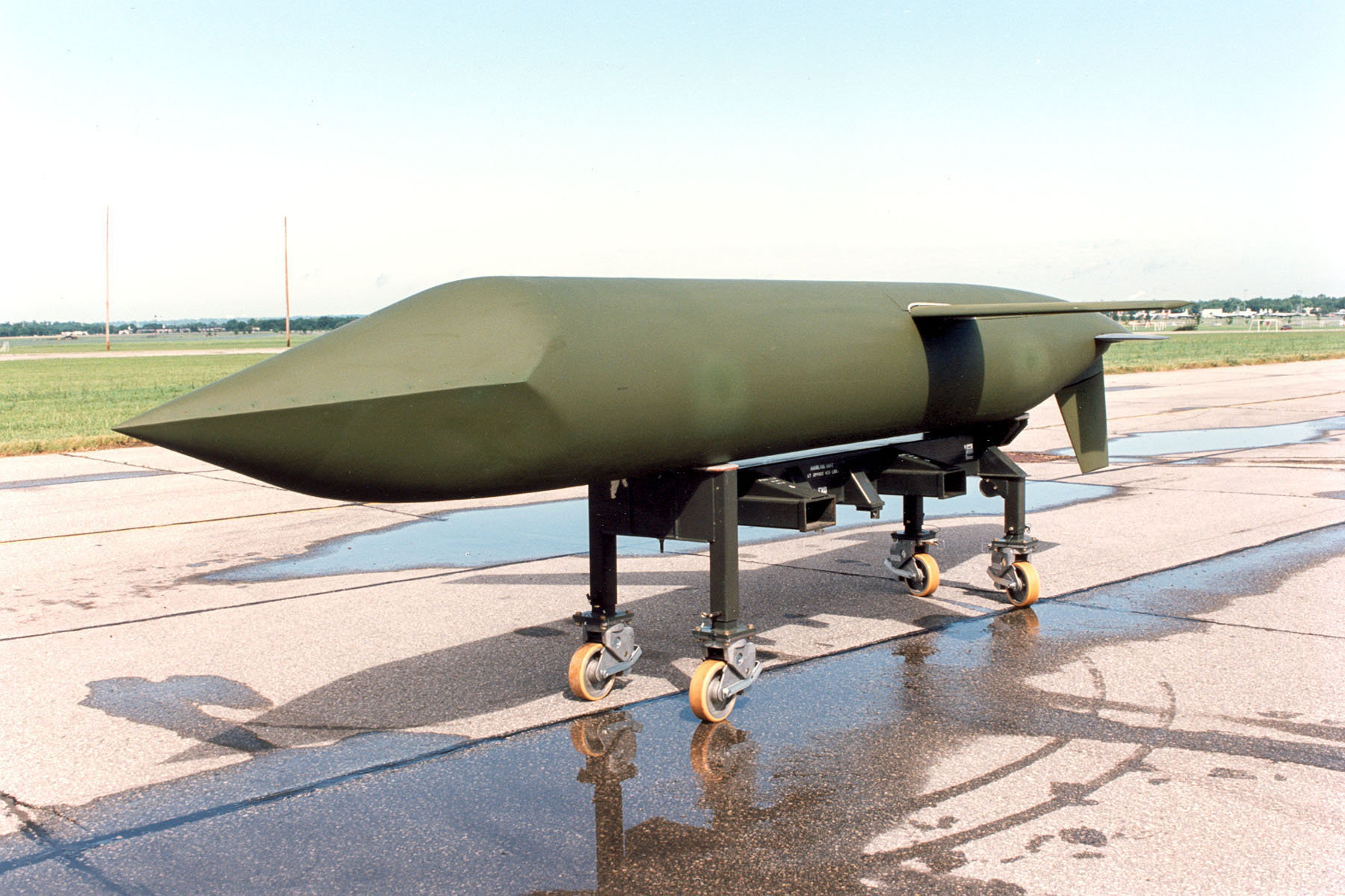Table Of Content

Tinker's role with the air launched cruise missile centers around the sustainment, repair and overhaul of the F107 turbofan engine along with continuing software upgrades. The F107 is a two-shaft engine weighing a mere 146 pounds yet capable of producing 600 pounds maximum thrust. The missiles follow preprogrammed attack routes after being dropped from the wings of the B-52s. A major cable news network captured multiple missiles as they cruised toward and struck high-value targets with live-narration riveting the audience and sending the leadership of Iraq in to hiding.
More articles about the AGM-86 ALCM
Instead, in January 1977, the Air Force began full-scale development of the AGM-86B, which greatly enhanced the B-52's capabilities and helped America maintain a strategic deterrent. It entered operational use on the B-52H in August 1981 and became its primary weapon in December 1982. The air-launched cruise missile had become operational four years earlier, in December 1982. More than 100 launches have taken place since then, with a 90% approximate success rate. For this role, the accuracy of the original INS guidance hardware was not enough. To provide the accuracy needed to attack the SAM sites with a small warhead, some system was needed to zero out the drift in-flight, and for this need, a radar-based TERCOM system was added.
AGM-86 Air-Launched Cruise Missile
The conversion process entails replacing nearly every part including modifying the engine, updating the guidance systems, and removing the nuclear warhead. Soon after development began, it was noted that the very small nuclear warheads being developed at that time could be fit to SCAD without seriously affecting its performance as a decoy. This would allow it to act as a decoy for much of its flight, and then deliberately approach a selected defensive site and attack it.
List of cruise missiles
The AGM-86B is then able to fly complicated routes to a target through use of a terrain contour-matching guidance system. The AGM-86C/D uses an onboard Global Positioning System coupled with its inertial navigation system to fly. This allows the missile to guide itself to the target with pinpoint accuracy. The United States Air Force (USAF) deploys an air-launched cruise missile, the AGM-86 ALCM. The Boeing B-52 Stratofortress is the exclusive delivery vehicle for the AGM-86 and AGM-129 ACM.
AGM-86C/D Conventional ALCM (CALCM) Variants
The weapon's concept was over a half-century old, but inadequate technology hadprevented development of an effective missile. Two technical breakthroughs in the early 1970stransformed the concept into a practical weapon system. The first breakthrough came in computertechnology, specifically a dramatic reduction in the physical size of computers coupled with equallydramatic increases in computer capabilities. These achievements fostered the development of asophisticated guidance system that enabled the missile to fly at very low altitudes, making detectiondifficult.
USAF 'off-ramps' Lockheed in LRSO competition - Jane's
USAF 'off-ramps' Lockheed in LRSO competition.
Posted: Tue, 21 Apr 2020 07:00:00 GMT [source]
Air Force received a final proposal for the Long-Range Standoff Weapon (LRSO) and is preparing to seek approval for the system’s engineering and manufacturing development. Scheduled for May 2021, about nine months earlier than expected, the pending authorization would officially create a program of record for the multibillion dollar nuclear... Over the last few years, the US military has been developing the AGM-181 Long-Range Standoff Weapon (LRSO) as a replacement for the AGM-86. This will be fired from the B-52H and the upcoming B-21 Raider as a tactical nuclear weapon (TNW).
Stay up-to-date with missile defense
These missiles have a range of over 1,000 kilometres (620 mi) and fly at about 800 kilometres per hour (500 mph).[37] They typically have a launch weight of about 1,500 kilograms (3,300 lb)[38] and can carry either a conventional or a nuclear warhead. Earlier versions of these missiles used inertial navigation; later versions use much more accurate TERCOM and DSMAC systems. While ballistic missiles were the preferred weapons for land targets, heavy nuclear and conventional weapon tipped cruise missiles were seen by the USSR as a primary weapon to destroy United States naval carrier battle groups.
Raytheon to Build New Nuclear Cruise Missile - Arms Control Association
Raytheon to Build New Nuclear Cruise Missile.
Posted: Sat, 16 May 2020 07:00:00 GMT [source]
Future of the ALCM
Either change would make it too large to fit on the SRAM launchers and the extended-fuselage version would be too large to fit in the bomb bay of the new B-1 Lancer bomber. The Air Force intended to replace the original ALCM with the new version at some future date. Missile Threat brings together a wide range of information and analyses relating to the proliferation of cruise and ballistic missiles around the world and the air and missile defense systems designed to defeat them. Missile Threat is a product of the Missile Defense Project at the Center for Strategic and International Studies.
Although the concept was proven sound and the 500-megawatt engine finished a successful test run in 1961, no airworthy device was ever completed. This led to the adoption of low-level attacks, where the bombers would fly below the radar horizon so they could not be seen on ground-based radars. Quail, originally designed for the high-altitude mission, was modified with the addition of a barometric altimeter to allow it to fly at lower altitudes. In the early 1960s, the Air Force began to question the usefulness of Quail in the face of improving Soviet defenses. In February 1974, the Air Force entered into contract to develop and flight-test the prototype AGM-86A air-launched cruise missile, which was slightly smaller than the later B, C and D models.
CALCM was retired in early 2019 and the inventory is stored at Barksdale awaiting disposal. ALCM is undergoing SLEP/component remanufacture to stretch its in-service life to 2030, allowing for replacement by the Long-Range Standoff (LRSO) missile. The final 50 missiles that were converted from the AGM-86B are the AGM-86D. The airmen and crews who participated in Prairie Vigilance 24-3 belonged to the 5th Bomb Wing based at Minot AFB in North Dakota and the 2nd Bomb Wing at Barksdale AFB in Louisiana. The Navy has admitted that all of its key shipbuilding programs -- from the new Columbia-class submarine to the new...
The concept started as a long-range drone aircraft that would act as a decoy, distracting Soviet air defenses from the bombers. As new lightweight nuclear weapons emerged in the 1960s, the design was modified with the intent of attacking missile and radar sites at the end of its flight. An air-launched cruise missile (ALCM) is a cruise missile that is launched from a military aircraft. Current versions are typically standoff weapons which are used to attack predetermined land targets with conventional, nuclear or thermonuclear payloads.

Another four-and-a-half-minute video showed the daunting process of tractors carrying the missiles reaching the parked B-52Hs, and the AGM-86 being lifted, attached, and screwed into the pylons. This ‘munitioning’ process can be assumed to be followed by extensive electrical and fire control system tests to check the missile’s integration with the B-52’s avionics and targeting. The first example, similar to the original SCAD in most ways, flew for the first time in March 1976, and its new guidance system was first tested that September. The USAF adopted the AGM-86 for its bomber fleet while AGM-109 was adapted to launch from trucks and ships and adopted by the USAF and Navy.
The AGM-86B air-launched cruise missiles and AGM-86C/D conventional air-launched cruise missiles were developed to increase the effectiveness of U.S. The CALCM has been used since the 1990s for long-range precision strike on the opening hours of conflict. The ALCM traces its history to the ADM-20 Quail missile, which began development in February 1956. The small jet-powered drone aircraft had a simple inertial navigation system (INS) that allowed it to fly a pre-programmed course that would make it visible to known Soviet defensive sites. A number of radar jammers and radar reflectors were intended to make it appear like a B-52 on a radar display. The small, winged AGM-86B/C/D missile is powered by a turbofan jet engine that propels it at sustained subsonic speeds.
The AGM-86 missile continues to be used by the US Air Force bomber fleet and can be carried internally by the B-52 using the common strategic rotary launcher to reduce parasitic drag and increase the range of the aircraft. The missile is also certified for employment with the B-1B Lancer and B-2A Spirit fleet of bombers. Designed to carry either a conventional or nuclear warhead, it had a turbofan jet engine, flew at subsonic speeds, had a range of 1,125 kilometers (700 miles), and used an inertial navigation system with terrain-contour matching radar. Because the missile flew close to the ground, it was difficult for enemy radars to detect. Most AGM-86As were used in flight tests in 1976, and none became operational. Subsequent versions of the ALCM with conventional or nuclear warheads and a longer range have been produced and deployed on B-1 and B-52 bombers.
The 06/III (RP-216) and 06/IV (RP-212) contained gyroscopic guidance systems.[5] The vehicle was designed to boost to 28 km altitude and glide a distance of 280 km, but test flights in 1934 and 1936 only reached an altitude of 500 meters. In June 1986 a limited number of AGM-86B missiles were converted to carry a high-explosive blast/fragmentation warhead and an internal GPS. This modification also replaced the B model's terrain contour-matching guidance system and integrated a GPS capability with the existing inertial navigation computer system.

Both missile types are configurable for either conventional or nuclear warheads. Modern cruise missiles are capable of traveling at high subsonic, supersonic, or hypersonic speeds, are self-navigating, and are able to fly on a non-ballistic, extremely low-altitude trajectory. The Air Force entered into a contract with Boeing Aerospace Company in February 1974 to developand flight test a prototype ALCM (designated AGM-86A). The first ALCM powered flight tookplace on 5 March 1976 over the White Sands Missile Range in New Mexico when a B-52G crewejected an ALCM from a SHAM rotary launcher.

No comments:
Post a Comment